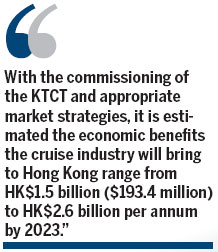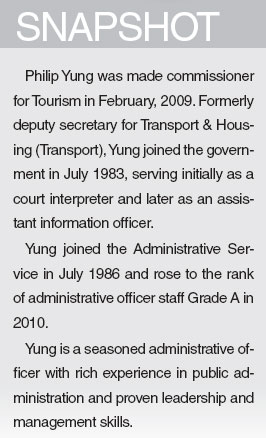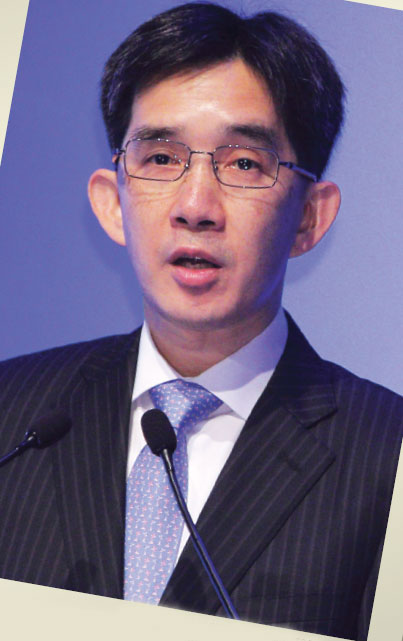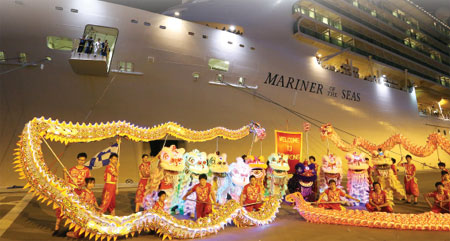Cruisin's bruisin' Battle Royale
Updated: 2013-08-30 07:46
By Wong Joon San(HK Edition)
|
|||||||
|
Commissioner for Tourism, Philip Yung, says the terminal operator of the Kai Tak Cruise Terminal has so far received bookings for 19 ship calls from October this year to April, 2014. Photo Supplied by Information services Department |
|
Two dragon dance troupes, with 10 lion dancers welcome guests of the "Mariner of the Seas", the first cruise liner to dock at Kai Tak Cruise Terminal. |
|
Provided by Government Information Services |

As Hong Kong's new Kai Tak Cruise Terminal has entered the fray to develop into Asia's leading destination for luxury liners, Commissioner for Tourism, Philip Yung, outlines the city's detailed plans to expand this market. Wong Joon San reports.
In his novel Battle Royale, Japanese writer Koushun Takami, spins a tale of junior high school students, forced to fight to the death among themselves, in a program under the aegis of an authoritarian Japan-based government, known as the Republic of Greater East Asia.
The battle to attract luxury liners among aspiring tourist destinations in South Asia, may be less dramatic nor the consequences so drastic, but the stakes for the cruise ship contenders have a life or death flavor. And Hong Kong is among the leading players. When award-winning cruise and travel writer Fran Golden, wrote in Travel Market Report: "Cracking Challenging Asia Cruise Market Is No Slam-Dunk", her description of the situation could not have been more perfect.
Golden outlines how the imported values and methods of Western cruise operators do not augur well for travel in Asia. She held out that Asians perceive cruises as cheap, short trips for gambling - a concept widely touted by Star Cruises, over the years.
As cruise tourism catches on, however, the perception of cruises among Asian travelers is expected to change. As more Asians become affluent, the industry is gearing up for an expected boom. Asia cannot compete with the Mediterranean for cruise ship destinations, for now, but the development of so many purpose-built cruise terminals will allow cruise lines like Cunard, Princess Cruises and Disney to offer more Asia-based packages.
"With the commissioning of the KTCT and appropriate market strategies, it is estimated that the economic benefits the cruise industry will bring to Hong Kong a range from HK$1.5 billion ($193.4 million) to HK$2.6 billion per annum by 2023," Commissioner for Tourism, Philip Yung says in an exclusive interview with China Daily.

The additional jobs generated by the cruise industry in Hong Kong, Yung says, will be around 5,300 to 8,900 by 2023.
The opening, on June 14, of the first berth of Hong Kong's $1.1 billion Kai Tak Cruise Terminal (KTCT) on the site of what was the old Kai Tak airport runway, made it possible for the largest cruise ships, up to 220,000 gross tons to add Hong Kong to their itineraries. The new facility, which boasts a breathtaking 360-degree panoramic view of the city, began drawing in the big luxury liners right away. Royal Caribbean's 1,020 foot (311 meter) cruise vessel Mariner of the Seas was the first mega luxury cruise liner to dock at the two-berth terminal.
The second berth at KTCT will be ready in mid-2014. With the city's existing facility at Ocean Terminal in full operation, Hong Kong is well prepared for cruise business in the near future.
"The terminal operator of the KTCT has so far received bookings for 19 ship calls from October this year to April, 2014 and 33 calls from mid-2014 to April 2015," Yung says, explaining that demand for Hong Kong as a destination is strong, despite keen rivalry.
Tourists to Hong Kong
Last year, the mainland continued to be the key driver of Hong Kong's cruise market, contributing 70 percent of the total passenger throughput. Hong Kong's proximity to Southern China makes it easy for mainland visitors to embark on their cruises here.
The completion of the Hong Kong-Zhuhai-Macao Bridge and the Guangzhou-Shenzhen-Hong Kong Express Railway will add to this competitive edge, Yung envisages.
"Hong Kong's central location makes it an ideal embarkation point for travelers heading northeast or southeast. Cruise operators will be able to offer a diversity of itineraries varying from a few days to weeks. That will furnish advantages both for the Asian market and the broader global market," Yung says, reflecting his expectations.
"For example, to the north, we offer short haul itineraries (five to six days) from Hong Kong to Naha, Cheju and Shanghai; or to the south from Hong Kong to Hainan, Vietnam and Singapore," Yung explains.
Some medium haul itineraries (nine to 15 days) will sail from Singapore to Ho Chi Minh City, then to Hong Kong, Xiamen and Shanghai; or sail from Hong Kong to Keelung, Nagasaki, Busan, Jeju, Tianjin and Shanghai, he elaborates, adding that some long-haul, world itineraries (40 days) will start from Sydney, sail to Brunei, Hong Kong, Shanghai, Busan, Nagasaki, Osaka, Tokyo, and return to Sydney.
"To cultivate the source market in Southern China, the Hong Kong Tourism Board (HKTB) is stepping up its promotion activities through advertising, public relations initiatives and digital marketing," Yung says, as he outlines the plan for moving Hong Kong's cruise industry forward.
Yung is optimistic about HKTB's plans to set up designated teams in major mainland cities, including Guangzhou and Shanghai, to encourage more mainland visitors to join cruises from Hong Kong.
He points out that the central government announced in June 2012 that mainland tour groups taking cruises from Hong Kong to Taiwan could visit Japan or Korea on the same journey before returning to the mainland. "The new policy will facilitate cruise companies organizing more diversified itineraries for mainland tourists and attract them to join cruise journeys from Hong Kong," Yung says.
Maximizing KTCT use
"Indeed, in designing the KTCT, we have taken into account the seasonal nature of cruise operations, and hence the potential low utilization of the terminal during certain times of the year (e.g. the typhoon season)," Yung says, deflecting criticisms that KTCT will become a white elephant.
"To maximize the flexibility in the utilization of the terminal, the terminal building has adopted a wide span layout with fewer structural columns. The design enables the waiting halls in the terminal to be used for conferences, exhibitions and banquets during the non-peak seasons of cruise operators," he elaborates.
The terminal operator has already expressed interest in hosting functions at the terminal building to optimize the use of the facility and generate additional revenue. The government is also working with the trade to organize a Cruise Holiday Expo at the terminal building in late September.
Aside from this, Yung says Hong Kong intends to broaden co-operation with Taiwan authorities to promote cruise tourism in the area. The de facto partnership already has reached an agreement with a cruise company for two additional cruise journeys between Hong Kong and Taiwan at the end of October and in early November.
"HKTB will also continue to participate in international forums, such as Cruise Shipping Miami to promote both the new terminal and Hong Kong as an essential cruise destination," the Tourism Commissioner elucidates, to reflect the broad areas being covered to promote Hong Kong and meet strong competition.
Apart from hospitality programs for arriving cruise passengers, Yung says the HKTB has launched its "New Tour Product Development Scheme" to encourage the local travel trade to develop new and innovative shore excursion programs, to offer additional enhancement to the onshore experience of cruise passengers.
Year-round events are being organized to create memorable travel experiences, linked to the Dragon Boat Festival, Mid-Autumn Festival, Halloween, Wine and Dine Festival, Winterfest and Chinese New Year Celebrations.
"In view of the significant increase in the (expected) number of visitor arrivals, the government is assessing the overall capacity of Hong Kong to receive tourists. The areas being looked at include the handling capacity of our boundary control points, receiving capacity of our tourist attractions and public transport system, supply of hotel rooms, economic benefits of the Individual Visit Scheme for mainland visitors, and its impact on the livelihood of the community, etc," Yung says, explaining why the government is proceeding cautiously forward.
Contact the writer at joonsan@chinadailyhk.com

(HK Edition 08/30/2013 page8)


